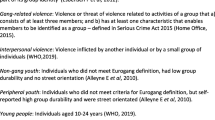Abstract
The primary purpose of the current study was to understand immigrant hate crime victimization in the U.S. Specifically, the authors analyzed the most recent data from the National Crime Victimization Survey to explore the factors that influence hate crime experiences and reporting by immigrant victims. Results from the binary logistic regression analyses revealed significant relationships between immigration status, citizenship status, number of prior incidents experienced as well as certain demographic characteristics and being the victim of a hate crime. Overall, being an immigrant or non-citizen, was associated with an increase in odds of being the victim of a hate crime. In terms of victims’ reporting of hate crime, immigration status had no impact, but the number of incidents experienced, being married and being less educated significantly increased reporting among victims. Numerous recommendations are provided, however, the most important step forward is the creation of a legal status category within the UCR’s Hate Crime data collection coupled with several legal protections for victims.
Similar content being viewed by others
Notes
This is when the Immigration and Nationality Act of 1965 (also known as the Hart-Celler Act) went into effect, thereby getting rid of the national origins system that had been used for almost a half century.
We conducted both Binary Logistic regression and Firth Binary Logistic regression (to address possible issues related with small sample size bias and potential separation issues) using Penalized Likelihood Estimation method - PMLE. however, after comparing the two results (PMLE and MLE), we found no real difference in the results. But, in terms of model fit, the MLE model was better. As such, we decided to conduct Binary logistic repression using the standard MLE method.
References
Barranco, R. E. (2013). Latino immigration, interaction, and homicide victimization. Sociological Spectrum, 33(6), 534–553.
Baumer, E., Messner, S., & Rosenfeld, R. (2003). Explaining spatial variation in support for capital punishment: A multilevel analysis 1. American Journal of Sociology, 108(4), 844–875.
Blalock, H. M. (1967). Towards a theory of minority group relations. New York: Capricorn Books.
Blumer, H. (1958). Race prejudice as a sense of group position. The Pacific Sociological Review, 1(1), 3–6.
Boateng, F. D., Pryce, D. K., & Chenane, J. L. (2020). I may be an immigrant, but I am not a criminal: Examining the association between the presence of immigrants and crime rates in Europe. Journal of International Migration and Integration, 1–20.
Boateng, F. D., McCann, W. S., Chenane, J. L., & Pryce, D. K. (2021). Perception of immigrants in Europe: A multilevel assessment of macrolevel conditions. Social Science Quarterly, 102(1), 209–227.
Burns, P., & Gimpel, J. (2000). Economic insecurity, prejudicial stereotypes, and public opinion on immigration policy. Political Science Quarterly, 115(2), 201–225.
Chiricos, T., Mcentire, R., & Gertz, M. (2001). Perceived racial and ethnic composition of Neighborhood and perceived risk of crime. Social Problems, 48(3), 322–340.
Cuevas, C., Farrell, A., McDevitt, J., Zhang, S., Temple, J., Robles, J., & Lockwood, S. (2019). Understanding and Measuring Bias Victimization Against Latinos. Washington, DC: National Institute of Justice Award # 2016-V3-GX-0001.
Cuevas, C., & Sabina, C. (2010). Sexual assault among Latinas (SALAS) study. Washington, DC: National Institute of Justice Award #: 2007-BX-0051.
Eitle, D., & Taylor, J. (2008). Are Hispanics the new ‘threat’? Minority group threat and fear of crime in Miami-Dade County. Social Science Research, 37(4), 1102–1115.
Esses, V., Dovidio, J., Jackson, L., & Armstrong, T. (2001). The immigration dilemma: The role of perceived group competition, ethnic prejudice, and National Identity. Journal of Social Issues, 57(3), 389–412.
Federal Bureau of Investigation, Uniform Crime Reports Hate Crime data, CY 2013–2018.
Gemignani, M., & Hernandez-Albujar, Y. (2015). Hate groups targeting unauthorized immigrants: Discourses, narratives and subjectivation practices on their websites. Ethnic and Racial Studies, 38(15), 2754–2770.
Gibson, C. L., & Miller, H. W. (2010). Crime and victimization among Hispanic adolescents: A multilevel longitudinal study of acculturation and segmented assimilation. Washington, DC: National Institute of Justice.
Green, D., Glaser, J., Rich, A., & Insko, C. A. (1998). From lynching to gay bashing: The elusive connection between economic conditions and hate crime. Journal of Personality and Social Psychology, 75(1), 82–92.
Grewal, G. (2018). Attorney general law enforcement directive no. 2018–6 v2.0: Directive strengthening trust between law enforcement and immigrant communities. Office of the Attorney General, State of New Jersey. Available at https://www.nj.gov/oag/newsreleases19/ag-directive-2018-6_v2.pdf
Gruenewald, J., & Allison, K. (2018). Examining differences in Bias homicide across victim groups. Crime & Delinquency, 64(3), 316–341.
Harlow, C. W. (2005). Hate crime reported by victims and police. Washington, DC: US Department of Justice, Office of Justice Programs, Bureau of Justice Statistics.
Higgins, G. E., Gabbidon, S. L., & Martin, F. (2010). The role of race/ethnicity and race relations on public opinion related to the immigration and crime link. Journal of Criminal Justice, 38(1), 51–56.
International Organization for Migration (2018). World migration report 2018. Available at http://publications.iom.int/books/world-migration-report-2018
Iwama, J. (2018). Understanding hate crimes against immigrants: Considerations for future research. Sociology Compass, 12(3), e12565. https://doi.org/10.1111/soc4.12565.
Jacobs, D., & Wood, K. (1999). Interracial conflict and interracial homicide: Do political and economic rivalries explain white killings of blacks or black killings of whites? American Journal of Sociology, 105(1), 157–190.
King, R. (2007). The context of minority group threat: Race, institutions, and complying with hate crime law. Law and Society Review, 41(1), 189–224.
King, R., & Brustein, W. (2006). A political threat model of intergroup violence: Jews in pre–world war II Germany. Criminology, 44(4), 867–891.
Klein, B. R., & Allison, K. (2018). Accomplishing difference: How do anti-race/ethnicity bias homicides compare to average homicides in the United States? Justice Quarterly, 35(6), 977–1003.
Luo, F., & Bouffard, L. A. (2016). Immigrants as victims: Examining the function of assimilation. Journal of Ethnicity in Criminal Justice, 14(2), 120–136.
Luo, F., & Zhao, J. S. (2017). Acculturation and fear of crime among Hispanics. Journal of Ethnicity in Criminal Justice, 15(1), 1–20.
McCann, W. S., & Pimley, N. (2019). Eliminating extremism: A legal analysis of hate crime and terrorism laws in the United States. Terrorism and Political Violence, 1–33.
McCann, W. S., & Boateng, F. (2020a). National Security and policy in America: Immigrants, crime, and the securitization of the border. London, U.K.: Routledge.
McCann, W. S., & Boateng, F. (2020b). An examination of American perceptions of the immigrant-crime relationship. American Journal of Criminal Justice, 45, 973–1002.
Nolan, J. J., Haas, S. M., Turley, E., Stump, J., & LaValle, C. R. (2015). Assessing the “statistical accuracy” of the National Incident-Based Reporting System Hate Crime Data. American Behavioral Scientist, 59(12), 1562–1587.
Ousey, G., & Kubrin, C. E. (2018). Immigration and crime: Assessing a contentious issue. Annual Review of Criminology, 1, 63–84.
Parkin, W., Gruenewald, J., & Jandro, E. (2017). Extremist violence from the fatherland to the homeland. International Criminal Justice Review, 27(2), 85–107.
Peguero, A. (2013). An adolescent victimization immigrant paradox? School-based routines, lifestyles, and victimization across immigration generations. Journal of Youth and Adolescence, 42(11), 1759–1773.
Rainie, L., & Perrin, A (2019). Key findings about Americans’ declining trust in government and each other. Pew Research Center: Trust, Facts, and Democracy. Available at https://www.pewresearch.org/fact-tank/2019/07/22/key-findings-about-americans-declining-trust-in-government-and-each-other/
Sessions, J. (2017). Remarks by Attorney General Jeff Sessions. https://www.justice.gov/opa/speech/attorney-general-jeff-sessions-delivers-remarks-2017-hate-crimes-summit.
Simich, L. & Kang-Brown, J. (2018). Questioning bias: Validating a bias crime victim assessment tool in California and New Jersey: Summary overview. National Institute of Justice Grant #2015-R2-CX-0037.
Soss, J., Langbein, L., & Metelko, A. (2003). Why do white Americans support the death penalty? The Journal of Politics, 65(2), 397–421.
Stacey, M., Carbone-Lopez, K., & Rosenfeld, R. (2011). Demographic change and ethnically motivated crime: The impact of immigration on anti-Hispanic hate crime in the United States. Journal of Contemporary Criminal Justice, 27(3), 278–298.
Stacey, M. (2015). The effect of law on hate crime reporting: The case of racial and ethnic violence. American Journal of Criminal Justice, 40, 876–900.
Sydes, M., Wickes, R., & Higginson, A. (2014). The spatial concentration of bias: An examination of the community factors that influence residents’ perceptions of bias crime. Australian & New Zealand Journal of Criminology, 47(3), 409–428.
United States. (2009). Departments of transportation and housing and urban development, and related agencies appropriations act, 2010: House report 111-366. Washington: U.S. G.P.O.
United States. Bureau of Justice Statistics. National Crime Victimization Survey, [United States]. (2017). Inter-university consortium for political and social research [distributor], 2020-03-23. https://doi.org/10.3886/ICPSR36981.v2.
Unnever, J., Cullen, D., & Roberts, F. (2005). Not everyone strongly supports the death penalty: Assessing weakly-held attitudes about capital punishment. American Journal of Criminal Justice, 29(2), 187–216.
Zaykowski, H. (2010). Racial disparities in hate crime reporting. (report). Violence and Victims, 25(3), 378–394.
Author information
Authors and Affiliations
Corresponding author
Additional information
Publisher’s Note
Springer Nature remains neutral with regard to jurisdictional claims in published maps and institutional affiliations.
Rights and permissions
About this article
Cite this article
McCann, W.S., Boateng, F.D. An Analysis of Hate Crime Victimization Amongst Immigrants. Am J Crim Just 47, 795–817 (2022). https://doi.org/10.1007/s12103-021-09616-x
Received:
Accepted:
Published:
Issue Date:
DOI: https://doi.org/10.1007/s12103-021-09616-x




